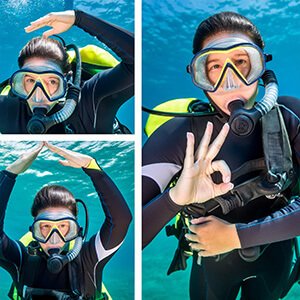
Enjoying the breathtaking splendor of the ocean’s depths is made possible by scuba diving. But there are hazards and safety standards unique to this kind of experience. Verbal communication is impossible in the huge, silent underwater realm, hence scuba diving hand signs is a lifeline. The meanings and appropriate times to utilize the hand signals that every scuba diver should know will be covered in this essay, along with how important they are to both fun and safety. Whatever your level of experience, every dive requires you to refine your knowledge of these underwater signs.
Sound carries differently underwater, so good luck trying to talk to your friend over the white noise of waves and the chorus of coral. Diving therefore depends on visual hand gestures to communicate vital information. The scuba world uses hand signals to communicate everything from problem alerts to thrilling discoveries to agreement on next steps. They are more inclusive than any spoken language in that every diver, regardless of their mother tongue, can interpret these global signs.
Imagine realising your companion has sailed out of sight after adjusting your buoyancy to capture the ideal photo of a stingray moving over the bottom. Imagine, too, the confusion of a night dive when your only communication tool is hand gestures. It is impossible to exaggerate the need of effective communication in such situations. Knowing how to use scuba diving hand signs means you can transmit vital information without using words.
From simple directional cues to complex safety procedures, scuba hand signs cover a wide range of communication needs. Each cue is designed to be clear and straightforward, allowing divers to understand each other quickly and efficiently. Below, we’ll break down the most critical scuba hand signals, providing not only their meanings but also when and how they should be used.
Learning to ‘speak’ underwater involves mastering a repertoire of hand signals. Below, you’ll find an in-depth exploration of the fundamental scuba diving hand signs:
When to Use It: If you or your buddy need to rise to the surface, the ‘ascend’ sign is critical. Use this signal to communicate that it’s time to begin your ascent, especially in response to an unforeseen situation where a quick rise is necessary.
When to Use It: The ‘descend’ hand signal tells your buddy that you’re ready to begin the descent. It’s also useful for confirming the intention to descend and checking that your buddy is prepared to follow.
When it’s time to go up, the ‘A-OK’ sign is the go-to. Thumb and forefinger in an ‘O’ with the remaining three fingers up means, “I am going to ascend.” It’s imperative to agree on an ascent signal before every dive in case you get separated from your buddy.
Celebratory messages about an amazing sight or feeling fantastic are what the ‘Awesome’ sign is for — make an ‘O’ with your thumb and forefinger and raise your arm triumphantly.

Are you approaching the boat? The boat hand sign isn’t too far from the American Sign Language sign for ‘B.’ Form your hand into an ‘L’ by touching your thumb to your index finger to signal, “I see the boat, and it’s time to surface.”

Perhaps you’ve noticed your buddy’s tank is asking for air? The ‘Breathe’ sign is similar to the ‘Awesome’ sign, but place your thumb against your cheek and puff your cheeks out. It’s your way of reminding, “I see you, breathe!”

When you need your buddy to stay close, try overlapping your little fingers from each hand. This is the surefire way of saying, “Hey, stick near, buddy.”

An open palm facing downward, motioning towards your body, is the universal way of beckoning your partner. If it’s time to share a find or just regroup, this is what you want to say.

For when you need to alert your buddy to something risky, keep it simple: one hand, slice it across your throat. It’s the visual cue that means, “Stop, danger ahead!”
Ready for the adventure to continue downward? The ‘Descend’ sign is similar to the ‘Ascend’ sign but moving your hand in a downward motion instead. It’s the nonverbal cue that says, “I’m going down.”

When conditions are rough or visibility is low, physically stay with your buddy by gently grasping their hand. This one needs no elaborate demonstration; safety first.

Put your hand up and pat your head. No, you’re not giving yourself a mental high-five; you’re asking your partner, “How much air do you have left?” This is a good signal to check and ensure everyone’s comfortable with their air supply mid-dive.

We all get a little shiver from time to time. Signal to your partner that it’s a bit chilly with one arm across your chest, rubbing it with the other. This isn’t just for complaints; it could be essential information in colder waters.
Sometimes, equalizing can be a persistent issue. To communicate that you’re having trouble, point to your ear with your index finger and give it a bit of a tug. That’s the ‘I have a problem with my ears’ signal.
When you’ve caught sight of something amazing and want to ensure your buddy shares the view, you need the ‘Look’ sign. Straighten your index finger and point in the direction of the sighting while looking there with intent.

Running low on air? Make a motion with your hand like you’re squeezing an orange. The gesture means that you’re nearly empty, and it might be time to think about ascending.
If you’re feeling the effects of nitrogen narcosis, it’s crucial to communicate it. Draw your palm across your face while looking confused, indicating to your buddy that something’s off and they should keep an eye out for you.

A straightforward ‘Everything’s fine’ signal is done by making an ‘O’ shape with your thumb and forefinger and showing it to your partner. It’s the reassurance they need that all is well.

In the event of a complete air outage, it’s a good idea to have a visual for “I’m out of air.” Tap the top of your head repeatedly with an open palm — a motion that’s tough to miss, even in low visibility.

This is the sign everyone hopes never to have to use. But if it’s necessary to share air, make a chopping motion at your neck with your flat palm. It’s saying, “I’m out of air; share with me,” and it’s a signal that shouldn’t be missed or misunderstood.

Maybe you’re not sure exactly what the issue is, but you know something’s off. Cross your arms over your chest. It’s the ‘something is wrong’ signal, which prompts your buddy to check in and see what’s going on.

The ‘Stop’ sign is pretty ubiquitous. Hand out, palm forward — halt, cease, desist. This could be for a buddy who’s getting too close to a delicate reef or just as a general ‘hold up’ signal.
A flat palm with your three middle fingers extended and facing outward —not your typical ‘hang ten’ but more like ‘hang five.’ This signals a planned three-minute safety stop at fifteen feet to off-gas.

Illustrate turning around by facing your partner, then using both hands to trace a large circle in the water. It’s a clear prompt for your buddy to turn back.

This combined set of instructions is useful for intricate maneuvers or underwater photography. Point to your eyes for ‘watch me,’ then gesture for your partner to lead and follow.
The above scuba diving hand signs cover many of the most frequent scuba communication needs. Understanding and using them regularly will make sure you’re prepared for any situation that might arise.
Scuba hand signals should be crisp and clear. A half-hearted gesture might be misunderstood in conditions where visibility can be quite limited. Regular practice can help you become more confident and precise with your non-verbal communication.
Each hand sign has a characteristic formation, and it’s essential to emulate these precisely. For example, the ‘out of air’ signal involves patting the top of your head with a flat palm, which many divers mistakenly mimic by tapping their reg or low-accuracy head patting.
Diving communities worldwide often have their variations of hand signals, born from regional needs or customs. Knowing these can bridge cultural divides and offer you a richer, more inclusive experience. For instance, “I want to touch your crab,” means something completely different in the US versus Mexico.
Mastering the art of communication is a crucial element of diver training. Instructors often use drills where students are only allowed to communicate through hand signals, reinforcing the importance of each sign.
Ongoing training through scenario reenactments helps divers prepare for real-life situations. Practicing in controlled environments like training pools can make all the difference in an emergency.
Experienced divers often have stories that highlight the vital role of hand signals. One diver recounts how the ‘share air’ signal saved a buddy from a potentially disastrous situation during a deep wreck dive. In another instance, the ‘out of air’ sign averted a crisis when a relatively new diver became unnerved at depth.
Those who have logged thousands of dives affirm the constant relevance of underwater signals. According to seasoned divers, fluency in hand signals builds confidence and fosters better buddy relationships.
Communication is a lifelong learning process, even in the silent world of scuba. By consistently practicing scuba hand signals, divers of all levels can forge a deeper, safer, and more enjoyable connection with the underwater environment.
Refinement comes with time and plenty of practice dives. Focusing on the details, such as the timing and clarity of your gestures, can elevate your underwater communication skills.
Like any language, fluency comes with practice. Regular skill drills are essential to ensure you are proficient in communicating underwater.
Before your next open water adventure, consider sharpening your signal-sending skills in a controlled environment. Practice with your regular buddy or a professional instructor.
Simulating challenging underwater situations – such as disorientation or equipment malfunction – prepares you for real-life scenarios. Role-play with different signaling intensities and distances to create a varied set of circumstances.
Mastering underwater communication is not just about survival; it’s about fully engaging with the beauty and wonder of the ocean. With this comprehensive guide to scuba hand signals, you’re on your way to becoming a more adept and responsible diver. Remember, in the realm of the reef, silence is golden, and effective hand signaling is your key to understanding and being understood. Your mastery of these essential underwater cues could save a life, enhance a moment, or simply ensure that your next scuba adventure is as flawless as the rolling tides themselves.